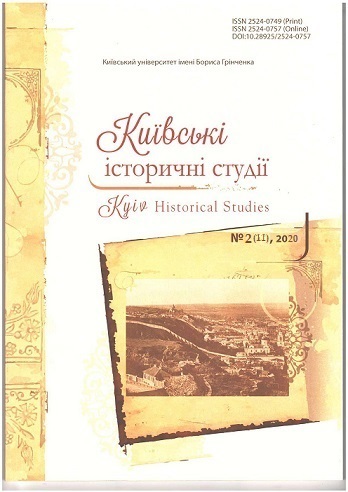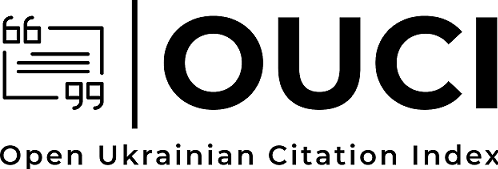“DISTANCE AND DISADVANTAGES OF TRAM TRAFFIC HAVE MADE ACCESS TO RESEARCH INSTITUTIONS DIFFICULT”: DWELLERS OF KYIV-PECHERSK MONASTERY IN 1920s — EARLY 1930s
DOI:
https://doi.org/10.28925/2524-0757.2020.2.5Keywords:
citizens, intellectuals, everyday life, Kyiv-Pechersk Lavra, All-Ukrainian Museum Town, KyivAbstract
The article deals with the (re)construction of tenant structure of the nationalized living quarters on Kyiv-Pechersk monastery area during 1920s — early 1930s, primarily persons associated with museums and/or the AllUkrainian Academy of Sciences. Their living conditions are outlined. The dependence of the local contingent both from the change of indirect owners of the buildings, (re)subordination of the territory, the formation, restructuring, liquidation of institutions, and from the processes of urbanization, which objectively caused the housing crisis in the USSR is elucidated. Well-known intellectuals of the interwar period lived in the former monastery buildings — archaeologists Petro Kurinnyi and Mykhailo Rudynskyi, an art critic Kost Moshchenko, a restorer Mykola Kasperovych, a cooperation connoisseur Ivan Oleksiiev, etc. The living conditions of Kyiv-Pechersk Preserve dwellers, including white-collar workers, were not ideal during 1920s and early 1930s. The distance of the apartments from the city center made access to research institutions (academic departments, book and museum collections) difficult. Almost everyone faced commonplace problems and trials: adaptation of monastery spaces, current repairs, furnishing of houses, humidity and low temperatures during the autumn-winter period, lack of heating, water supply, drainage, electricity, and other utilities, etc. Besides, Pechersk, the city suburb, was quite dangerous, the local population was often robbed. Families with children faced additional difficulties — providing access to educational institutions. The main part of Kyiv-Pechersk Preserve tenants–intellectuals were newcomers from other cities and towns. Therefore, museum workers and academics changed their apartments quite easily, not only within the so-called Citadel, 9 (Kyiv-Pechersk Preserve) in Kyiv but also within the country.
Downloads
References
Yanenko, A. (Comp.). (2017). Arkheolohichnyi muzei Vseukrainskoi akademii nauk: doslidzhennia i materialy. Kyiv: Natsionalnyi Kyievo-Pecherskyi istoryko kulturnyi zapovidnyk [in Ukrainian].
Bilokin, S. (2006). Muzei Ukrainy (Zbirka P. Pototskoho): Doslidzhennia, materialy. Kyiv: b. v. [in Ukrainian].
Bon, O. (2019). Oleksa Novytskyi i Serhii Hamchenko: povsiakdennia naukovtsiv 1920–1930-kh rokiv za epistoliarnymy dzherelamy. Materialy i doslidzhennia z arkheolohii Prykarpattia i Volyni, 4, 409–418 [in Ukrainian]. https://doi.org/10.33402/mdapv.2019-23-409-418
Ishchuk, O. (2016). Epizod politychnykh represii u Vseukrainskomu muzeinomu mistechku, 1937 r.: aresht ta zasudzhennia Kyryla Yukhymovycha Korshaka. Naukovyi visnyk Natsionalnoho muzeiu istorii Ukrainy, 1, I, 24–30 [in Ukrainian].
Sebta, T. M., & Kachan, R. I. (Comps.). (2016). Kyievo-Pecherska Lavra u chasy Druhoi svitovoi viiny: Doslidzhennia. Dokumenty. Kyiv: «Vydavets Oleh Filiuk» [in Ukrainian].
Koliastruk, O. (2010). Intelihentsiia USRR u 1920-ti roky: povsiakdenne zhyttia. Kharkiv: Rarytety Ukrainy [in Ukrainian].
Kot, S., & Rylkova, L. (2011). Budynok ikonopysnykh shkoly y maisterni ta kliuchni 1880–83, v yakomu mistyvsia Muzei arkhitektury Lavrskoho muzeiu kultiv ta pobutu, pratsiuvaly i prozhyvaly vidomi diiachi kultury. In Zvid pamiatok istorii ta kultury Ukrainy (Vol I., part III, pp. 1260–1262). Kyiv [in Ukrainian].
Poliushko, H. V. (2009). Okhorona pamiatok Kyievo-Pecherskoi lavry v 1920-kh rokakh: suchasnyi pohliad. Druhi Zarembivski chytannia. (pp. 193–200). Kyiv [in Ukrainian].
Rylkova, L. P. (2008). Biograficheskie svedeniia o bratii Kievo-Pecherskoi Lavry, postradavshei za Pravoslavnuiu veru v 20 stoletii. Kiev: Kievo-Pecherskaia lavra [in Russian].
Cherednychenko, A. M. (2013). F. I. Shmit ta F. M. Morozov: bilia vytokiv Muzeiu kultiv ta pobutu na terytorii Kyievo-Pecherskoi lavry (1920-ti rr.). Lavrskyi almanakh, 28, 77–85 [in Ukrainian].
Yanenko, A. (2019a). Lysty do Petra Kurinnoho: antolohiia budennoho v mizhvoiennomu misti. Materialy i doslidzhennia z arkheolohii Prykarpattia i Volyni, 4, 436–450 [in Ukrainian]. https://doi.org/10.33402/mdapv.2019-23-436-450
Yanenko, A. S. (2019b). “Oi shche y duzhe dovho treba chystyty «avhiievi koniushni»”: lysty Ivana Oleksiieva do Petra Kurinnoho yak dzherelo z istorii muzeinoho zhyttia Kyieva 1920-kh rr. Sivershchyna v istorii Ukrainy, 12, 385–398 [in Ukrainian].
Yanenko, A. (2020). Transformatsiia muzeinytstva ta radianizatsiia humanitarystyky v USRR na pochatku 1930-kh rr. (na prykladi providnyka Petra Kurinnoho Vseukrainskym muzeinym horodkom). In P. Kurinnyi, Vseukrainskyi derzhavnyi kulturno-istorychnyi zapovidnyk “Vseukrainskyi muzeinyi horodok”: providnyk (pp. 7–59). Kyiv: NKPIKZ [in Ukrainian].
Published
How to Cite
Issue
Section
License
Copyright (c) 2020 Анна Яненко

This work is licensed under a Creative Commons Attribution-NonCommercial-ShareAlike 4.0 International License.
Authors who publish in this journal retain the right of authorship of the work and give to the journal right of first publication of this work under the conditions of Creative Commons: Attribution-NonCommercial-ShareAlike 4.0 International (CC BY-NC-SA 4.0), which allows others freely distribute the work published with reference to the authors of the original work and the first publication of this magazine.














